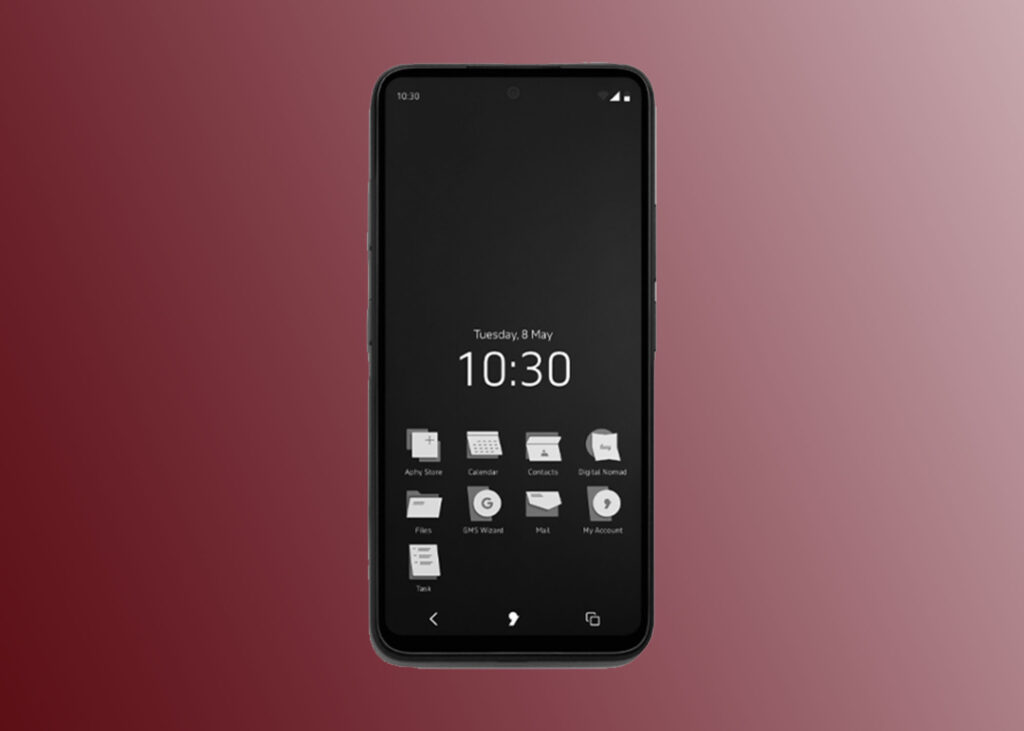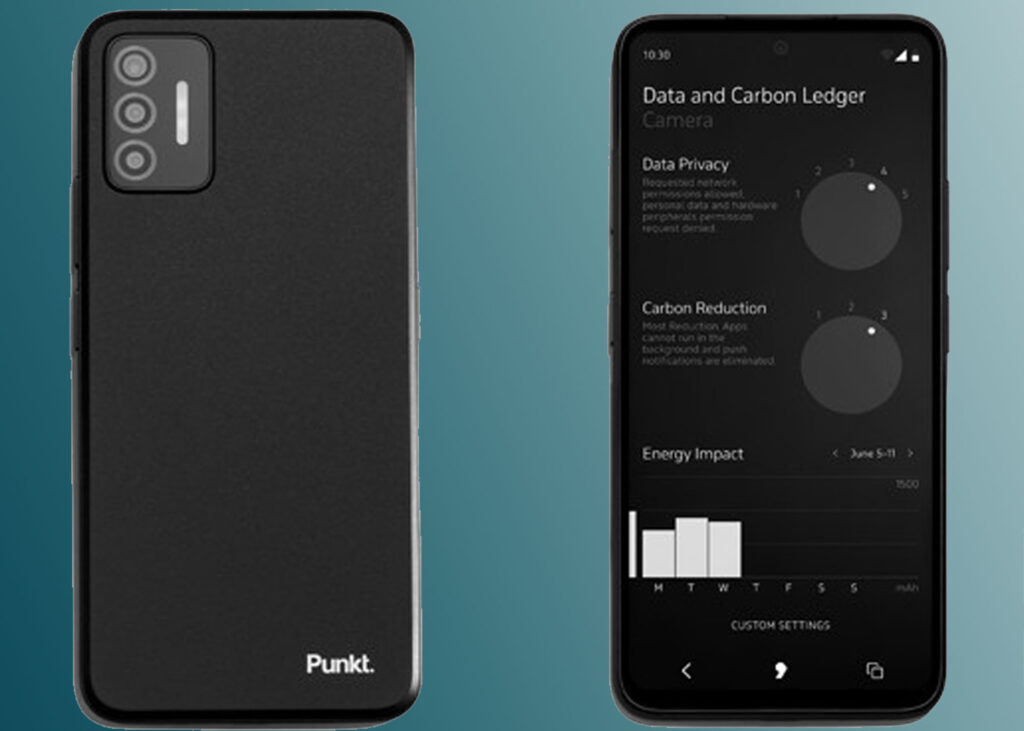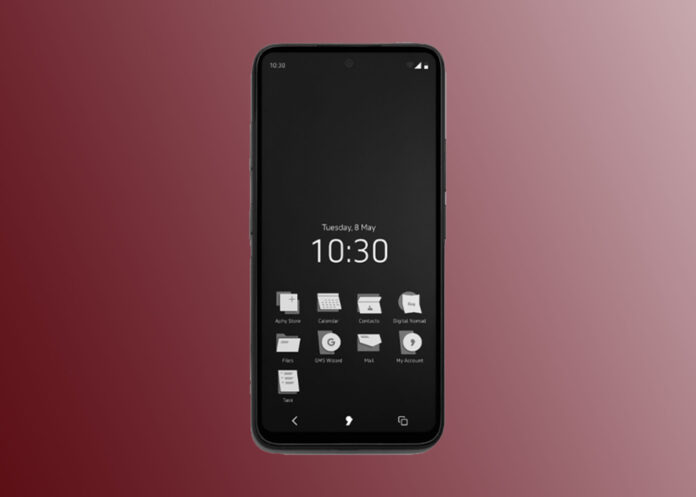Introducing a smartphone tailored for individuals who prefer uniqueness, challenging the mainstream by diverging from reliance on Google. Although embracing uniqueness holds value, the concept of a subscription-based phone or investing heavily in hardware typically priced at $400 or less might not resonate with consumers.
Advantages:
– Prioritizes security
– Supports wireless charging
Disadvantages:
– Requires a monthly subscription after the initial year
– Offers only 6GB/128GB storage in a phone positioned at a premium price point
– Lacks eSIM support
Punkt. Mc02 Quick Review
With the departure of Blackberry and Microsoft from the mobile phone market, consumers now have only two options for phone platforms: Apple and Google.
The limited choices resulting from this polarization may bother some individuals, and these are the customers that Punkt. aims to attract with the MC02.
The MC02 follows a conventional smartphone design, incorporating the MediaTek Dimensity 900 processor and providing 5G communication in addition to WiFi connectivity.
Punkt. asserts that this phone is revolutionary in allowing users to control their private data, rather than leaving it in the hands of Google or others. To achieve this goal, the Apostrophe OS includes its own calendar, contacts, and mail applications. Data from these applications is routed through secure VPN channels to a central storage facility located in Switzerland.
Your feelings about Switzerland might not align with this level of trust, but for purchasers of the Punkt. MC02, it’s the only geographical option available.
However, a more pressing concern for buyers is how to synchronize the data on the phone with their other digital devices. In essence, they can’t. While it’s possible to install the Google Play store and download apps from it, these apps are isolated from the system to ensure its safety. Nonetheless, without these apps, the MC02 cannot access data from various platforms since Apostrophy OS is exclusive to this phone.
This arrangement is acceptable if you never share photos, contacts, or emails, but it’s less than ideal if you do.
However, the potential deal-breaker here might be that while the first year of access to Apostrophy OS is complimentary after purchasing the phone, thereafter, users must pay 15 Swiss francs per month for the privilege of safeguarding their data in the Swiss Alps, instead of having it sold by Google, along with everyone else’s.
When considering this alongside the $750 price tag for the purchase, the cost of enhanced security may seem steep for those who aren’t Swiss bankers.
Punkt. MC02 Review: Pricing and Availability
What is the price? Starting from $750, €700.
When is it available? Now.
Where can you purchase it? Directly from Punkt.
There is only one color option (black) and one specification for the MC02, which is exclusively offered for order through Punkt. The listed price is $749 for customers in the US and €699 for those residing in the EU.
In comparison to another phone model featuring the same System on a Chip (SoC), the Doogee V30, the price gap is significant. The Doogee V30 is priced at approximately $299, is waterproof, has double the RAM, storage, and battery capacity, and boasts a 108MP camera sensor.
Hence, unless you find the security features of the MC02 worth $450 or more, it may not offer the most cost-effective option.
PUNKT. MC02 Review: Specifications
Processor: MediaTek Dimensity 900
Graphics: Mali-G68 MC4
Memory: 6GB LPDDR4X RAM
Storage: 128GB UFS 2.2
Display: 6.67-inch IPS screen with 60Hz refresh rate and 400 nits brightness
Resolution: 2400 x 1080 pixels
SIM: Dual Nano SIM (or one SIM and MicroSD)
Weight: 230 grams
Dimensions: 165.9 x 77.8 x 10.9mm
Durability Rating: Not Applicable
Rear Cameras: 64MP Main, 8MP Ultrawide, 2MP Macro
Front Camera: 24MP
Connectivity: WiFi 6, Bluetooth 5.2
Operating System: Apostrophe OS
Battery Capacity: 5500mAh (Max charge 33W), supports 18W wireless charging
Color Options: Black
Warranty Period: 2 years
PUNKT. MC02 Review: Design
Simplicity
Monochrome interface
The core principle of Punkt. since its inception has been to streamline technology to include only the essentials that people truly desire. While the MC02 doesn’t go as minimalist as its predecessors, the MP01 or MP02, this phone’s distinct external features make it somewhat challenging to describe.
The MC02 presents itself as a black rectangular device crafted from impact-resistant plastic and glass. It features a USB-C port at the bottom, with power and volume buttons located on the right side, alongside a custom button and SIM card slot. The top houses a 2.5mm audio jack.
At the rear, the Punkt. logo sits in the bottom right corner, while the camera cluster is positioned at the top left. The majority of the back is a flat textured surface designed specifically for wireless charging.
The most prominent element of the design is the 6.67-inch IPS panel, which lacks a fingerprint sensor and operates at a standard 60Hz refresh rate. Initially, one might mistake the screen for monochrome due to the predominantly black and white standard icons.
However, this perception changes when non-Punkt. branded apps are installed, revealing the screen’s full-color capabilities. This design choice may discourage excessive phone usage.
While a monochrome screen could potentially offer significant power savings by reducing LCD layers, this is not the intended objective here.
Punkt. does not address the phone’s durability in its information, implying it may not withstand exposure to water, dust, or drops. Furthermore, the warranty period is only two years, shorter than what is offered by other phone manufacturers.
Overall, considering its relatively high price tag, the MC02 appears rather unremarkable from an external standpoint.

PUNKT. MC02 Review: Hardware
Density 900 Processor
Limited to 60Hz refresh rate
Modest battery capacity
This is not the first time we’ve encountered the Dimensity 900 processor in a review. Previously, we examined this System on a Chip (SoC) in the Doogee V30 and the Ulefone Armor 18T. The same chip is utilized in numerous Chinese-manufactured devices, including those from Honor, Vivo, OnePlus, Oppo, Infinix, and Coolpad, among others.
It’s important to highlight that most of these phones are priced below $400, with some even below $200. Many of them offer 8GB of RAM and 256GB of storage, even at these lower price points.
As far as SoCs are concerned, the Dimensity 900 is a mid-range processor that has been succeeded by newer Dimensity designs since its introduction in 2021.
Its key features include a balanced mix of performance and efficiency cores, a respectable GPU in the Mali-G68 MC4, and an integrated mobile modem that supports both older GSM technology and newer 4G and 5G communications.
One minor disappointment is the screen. While IPS panels of this resolution are commonplace in phones of this size, higher-end devices typically offer 120Hz refresh rates and brightness exceeding 450 nits. The choice of a 60Hz refresh rate and 400 nits brightness suggests that cost considerations were prioritized over other factors.
The last component, aside from the cameras which we’ll discuss shortly, is the battery. While a 5500mAh battery may suffice for some users, it falls short of current standards. It should last a day under normal usage, but it may struggle to keep the phone running for multiple days without access to charging.
Additionally, the phone supports wireless charging, although a wireless charger is not included.
One feature that could have been beneficial to include in this phone is eSIM support. However, Punkt. opted for the conventional dual-SIM model, where users must sacrifice one SIM slot to use a MicroSD card. Given the limited storage provided, eSIM support could have been a way to address this issue, but this opportunity was not pursued.
To put it simply, the internal hardware of the MC02 resembles what one would expect to find in a $300 phone, not one priced twice as high or more.
PUNKT. MC02 Review: Cameras
Main sensor: 64MP
Ultrawide: 8MP
Video recording: 4K
The Punkt. MC02 is equipped with four cameras:
Interestingly, Punkt. is somewhat reserved about disclosing the specifics of the camera sensors in this phone.
What we do know is that the main sensor boasts 64MP, complemented by an 8MP ultra-wide and a 2MP macro lens. Our assumption, based on the limited information provided by device information apps, is that the rear sensor set is likely from OmniVision.
It could potentially feature the 64MP OmniVision ov64b40 and 8MP OmniVision ov08d10, although we cannot confirm this. The front-facing sensor, rated at 24MP, suggests it might be a Samsung design, given their offerings with similar specifications.
These sensors capture images that are satisfactory but not particularly impressive, and the main sensor struggles to adjust to suboptimal lighting conditions adequately.
However, this isn’t a significant concern, as most people wouldn’t purchase this phone primarily for its photography capabilities. Similar to other hardware components, the cameras on the MC02 are somewhat average.
The most notable aspect of the primary camera is its support for 4K video recording, although it lacks frame rate control. The downside of 4K video is its substantial storage consumption, but Punkt. deemed the 128GB of storage to be sufficient.
An ironic aspect of the video system is that this phone lacks support for Widevine L1 encryption, the technology used by streaming services to safeguard their content. This likely means that accessing streams with resolutions higher than 480p from certain services may not be possible.

PUNKT. MC02 Review: Performance
Subpar SoC
Battery lasts for two days
| Phone | Punkt. MC02 | Doogee V30 |
|---|---|---|
| SoC | Density 900 | Dimensity 900 |
| Storage | 6GB/128GB | 8GB/256GB |
| GeekBench Single | 686 | 694 |
| Multi | 2107 | 2108 |
| OpenCL | 2531 | 2588 |
| PCMark10 Score | 10257 | 10005 |
| Passmark Score | 10388 | 10737 |
| CPU | 5337 | 5281 |
| 3DMark Slingshot OGL | 5160 | 5165 |
| Slingshot Ex. OGL | 4049 | 4033 |
| Slingshot Ex. Vulkan | 3814 | 3829 |
| Wildlife | 2177 | 2187 |
These benchmarks reveal that the Apostrophy OS can’t extract any more performance from the Dimensity 900 than the one used by Doogee. If anything, the security model implemented by this phone may slightly slow it down.
One test we omitted from our table was the PCMark Work 3.0 battery life examination, where the MC02 managed a respectable 19 hours and 39 minutes on a full charge. This suggests the phone might last at least two days of use without recharging, which is acceptable for a phone weighing only 230g.
It wouldn’t be fair to compare the battery life with the V30 since it has a 10800mAh battery, almost double that of the MC02.
Overall, this phone performs adequately, but it’s hardly remarkable.
PUNKT. MC02 Review: Security
Punkt. expends significant effort to refrain from mentioning the word ‘Android’ in its promotional material. Upon closer examination, it becomes apparent that secure applications, such as the Vanadium browser, originate from a derivative of Android 13 named GrapheneOS. This is a specialized version of Android, designed to be a private and secure mobile operating system while maintaining compatibility with Android apps. Importantly, GrapheneOS is open source, allowing some of its components to be utilized by Apostrophy.
Regardless of how Android is modified, to achieve any level of compatibility with Android apps, a subsystem of Android must be present within both GrapheneOS and Apostrophy OS.
Consequently, while the security model employed by the MC02 differs from that of devices like the Google Pixel, it is arguably more secure. There is a degree of shared code, which could potentially allow an exploit effective on vanilla Android 13 to also affect Apostropy OS.
However, Punkt. deliberately refrains from pre-installing the Google framework structures and apps, which are the primary targets for security breaches, thus inherently enhancing its security.
The major drawback, however, is that most individuals purchase an Android phone precisely for access to these apps and services. We anticipate that the majority of MC02 customers will likely install the Google Play store and use the device similarly to any other Android phone, driven by human nature.
This choice undermines many of Punkt.’s original design principles, albeit for practical reasons.
It’s worth noting that the initial Punkt. phones advocated for reducing distractions and providing only essential functionality. Yet, if one desires to avoid being tracked by Google or similar entities, and wishes to eschew the allure of the app ecosystem, purchasing an old Nokia from eBay would be a more economical option with remarkable battery life.
While the phone includes a built-in VPN, after one year of usage, a monthly subscription becomes necessary to continue utilizing Apostrophy services. With this expenditure, one could instead opt for a standalone VPN subscription and have funds remaining.
Conclusion
It’s clear why individuals seek to distance themselves from Apple and Google, but does the MC02 genuinely embody independence, or does it merely attempt to portray it?
After using it extensively, I remain uncertain about the extent to which a phone utilizing Android can truly detach itself from its Google origins. What casts doubt on this is that the primary action most users take is signing into Google Play to acquire necessary apps.
The genuine threat of Android lies in the potential download and installation of malicious applications, a risk not entirely mitigated by the MC02.
In essence, this appears to be a considerable investment for those avoiding smartphones due to security concerns or a desire to evade data collection.
Regardless of how Punkt. modifies Android in the MC02, it will never match the security level of either a basic phone or no phone at all.

